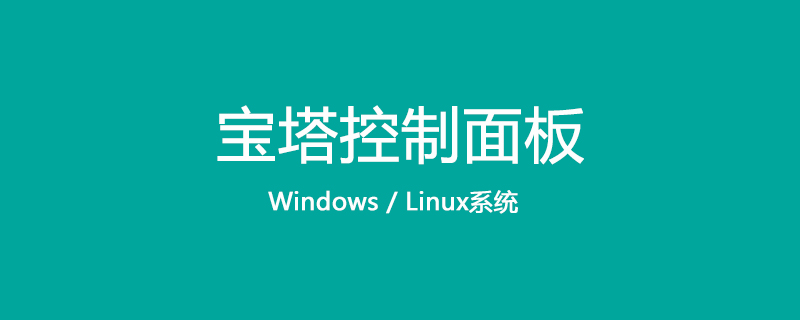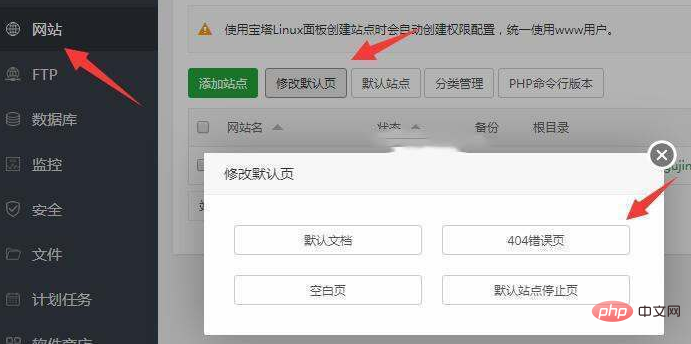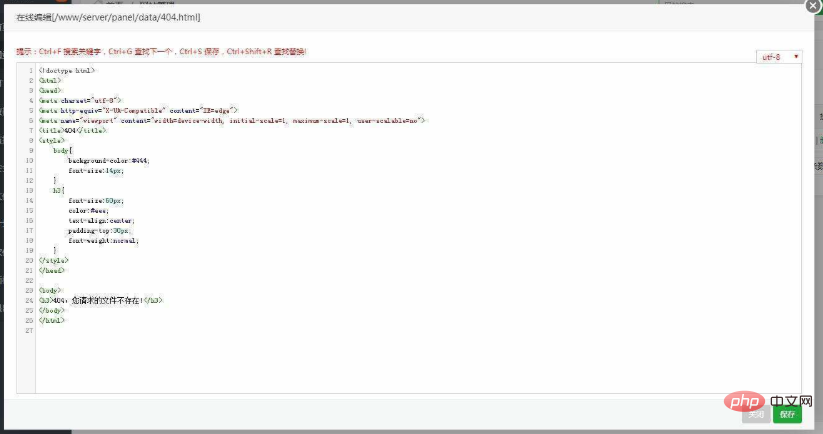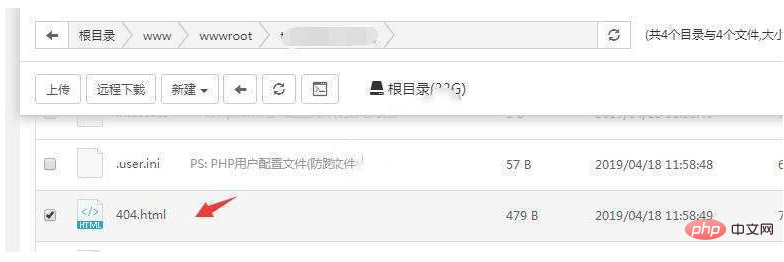 Topics
Topics
 Pagoda Panel
Pagoda Panel
 Pagoda Linux panel modifications such as 404 error page and other default pages
Pagoda Linux panel modifications such as 404 error page and other default pages
Pagoda Linux panel modifications such as 404 error page and other default pages
The site created using the Pagoda Linux panel has 4 default pages, namely the default document, 404 error page, blank page and default site stop page. These default pages are all the same. Is there any way to modify them to more personalized pages? The Pagoda Panel tutorial column will introduce the method below!

If you just want to change the default page to a personalized page, please continue reading this article (PS: This article takes the example of changing the default 404 error page to the Tencent Charity 404 page. Continue to explain).
1. Log in to the Pagoda Web Panel>> Click "Website" on the left menu>> Click the [Modify Default Page] button>> Click the [404 Error Page] button, as shown in the figure below Display:

2. When editing 404.html online, directly delete the code of the file and paste the following Tencent Public Welfare 404 page code. Finally, remember to click the [Save] button.
<!doctype html> <html> <head> <meta charset="utf-8"> <meta name="description" content="boke112 导航的 404 错误页面,当您看到这个页面,表示您的访问出错,这个错误是您打开的页面不存在,请确认您输入的地址是正确的!虽然你访问的页面找不回来了,但是我们可以一起寻找失踪宝贝!" /> <meta name="keywords" content="404,404 错误页面,boke112 导航,一起寻找失踪宝贝,404 公益计划" /> <title>404 - 对不起,您查找的页面不存在 _ 一起寻找失踪宝贝 _boke112 导航</title> </head> <body> <script type="text/javascript" src="//qzonestyle.gtimg.cn/qzone/hybrid/app/404/search_children.js" charset="utf-8" homePageUrl="/" homePageName="返回 boke112 导航"></script> </body> </html>

Originally, it will take effect after clicking the [Save] button. However, when accessing an error path, the previous 404 error page is still displayed. , and then restarted nginx, PHP, server, etc., but it still failed to take effect. Later, I discovered that there was a 404.html file in the root directory of the site. By renaming the file, the site's 404 error page became the nginx error page instead of the Tencent Public Welfare 404 page.
Finally gave up on this modification method. In fact, the simplest way is to create a 404.html file directly in the root directory of the site, then add the code of Tencent Public Welfare 404 page to this 404.html file and save it. It can take effect immediately.

As for the three default pages of the default document, blank page and default site stop page, I have not modified and tested them one by one. If you are interested, you can refer to the previous steps in this article. Give it a try, after all, what we usually modify the most is actually the 404 error page.
The above is the detailed content of Pagoda Linux panel modifications such as 404 error page and other default pages. For more information, please follow other related articles on the PHP Chinese website!

Hot AI Tools

Undresser.AI Undress
AI-powered app for creating realistic nude photos

AI Clothes Remover
Online AI tool for removing clothes from photos.

Undress AI Tool
Undress images for free

Clothoff.io
AI clothes remover

Video Face Swap
Swap faces in any video effortlessly with our completely free AI face swap tool!

Hot Article

Hot Tools

Notepad++7.3.1
Easy-to-use and free code editor

SublimeText3 Chinese version
Chinese version, very easy to use

Zend Studio 13.0.1
Powerful PHP integrated development environment

Dreamweaver CS6
Visual web development tools

SublimeText3 Mac version
God-level code editing software (SublimeText3)

Hot Topics
 What computer configuration is required for vscode
Apr 15, 2025 pm 09:48 PM
What computer configuration is required for vscode
Apr 15, 2025 pm 09:48 PM
VS Code system requirements: Operating system: Windows 10 and above, macOS 10.12 and above, Linux distribution processor: minimum 1.6 GHz, recommended 2.0 GHz and above memory: minimum 512 MB, recommended 4 GB and above storage space: minimum 250 MB, recommended 1 GB and above other requirements: stable network connection, Xorg/Wayland (Linux)
 Linux Architecture: Unveiling the 5 Basic Components
Apr 20, 2025 am 12:04 AM
Linux Architecture: Unveiling the 5 Basic Components
Apr 20, 2025 am 12:04 AM
The five basic components of the Linux system are: 1. Kernel, 2. System library, 3. System utilities, 4. Graphical user interface, 5. Applications. The kernel manages hardware resources, the system library provides precompiled functions, system utilities are used for system management, the GUI provides visual interaction, and applications use these components to implement functions.
 vscode terminal usage tutorial
Apr 15, 2025 pm 10:09 PM
vscode terminal usage tutorial
Apr 15, 2025 pm 10:09 PM
vscode built-in terminal is a development tool that allows running commands and scripts within the editor to simplify the development process. How to use vscode terminal: Open the terminal with the shortcut key (Ctrl/Cmd). Enter a command or run the script. Use hotkeys (such as Ctrl L to clear the terminal). Change the working directory (such as the cd command). Advanced features include debug mode, automatic code snippet completion, and interactive command history.
 How to check the warehouse address of git
Apr 17, 2025 pm 01:54 PM
How to check the warehouse address of git
Apr 17, 2025 pm 01:54 PM
To view the Git repository address, perform the following steps: 1. Open the command line and navigate to the repository directory; 2. Run the "git remote -v" command; 3. View the repository name in the output and its corresponding address.
 How to run java code in notepad
Apr 16, 2025 pm 07:39 PM
How to run java code in notepad
Apr 16, 2025 pm 07:39 PM
Although Notepad cannot run Java code directly, it can be achieved by using other tools: using the command line compiler (javac) to generate a bytecode file (filename.class). Use the Java interpreter (java) to interpret bytecode, execute the code, and output the result.
 Where to write code in vscode
Apr 15, 2025 pm 09:54 PM
Where to write code in vscode
Apr 15, 2025 pm 09:54 PM
Writing code in Visual Studio Code (VSCode) is simple and easy to use. Just install VSCode, create a project, select a language, create a file, write code, save and run it. The advantages of VSCode include cross-platform, free and open source, powerful features, rich extensions, and lightweight and fast.
 What is the main purpose of Linux?
Apr 16, 2025 am 12:19 AM
What is the main purpose of Linux?
Apr 16, 2025 am 12:19 AM
The main uses of Linux include: 1. Server operating system, 2. Embedded system, 3. Desktop operating system, 4. Development and testing environment. Linux excels in these areas, providing stability, security and efficient development tools.
 How to run sublime after writing the code
Apr 16, 2025 am 08:51 AM
How to run sublime after writing the code
Apr 16, 2025 am 08:51 AM
There are six ways to run code in Sublime: through hotkeys, menus, build systems, command lines, set default build systems, and custom build commands, and run individual files/projects by right-clicking on projects/files. The build system availability depends on the installation of Sublime Text.





